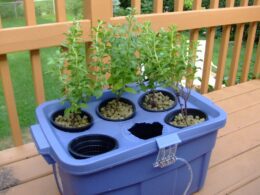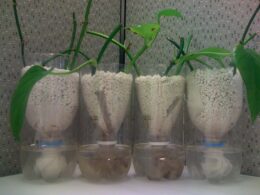Are you wondering if it’s safe to consume hydroponic lettuce? With the rise of vertical farming and hydroponic systems, it’s important to understand the potential safety concerns and benefits of this type of produce.
Hydroponic lettuce is grown in a soil-free environment using nutrient-rich water, making it a popular choice for those looking for a sustainable and efficient way to grow their own produce. However, you may be wondering if this method of cultivation is safe for consumption.
In this article, we will explore the safety concerns surrounding hydroponic lettuce and provide you with information on its nutritional value and benefits, as well as guidelines for food safety.
What is Hydroponic Lettuce?
Growing lettuce without soil is a popular method known as hydroponics. This method involves growing plants in a water-based solution with added nutrients that provide all the necessary elements for plant growth.
Unlike traditional farming, hydroponic lettuce is grown in a controlled environment, such as a greenhouse, where factors like temperature, light, and humidity can be optimized for maximum growth. Vertical farming is a popular form of hydroponic farming where plants are grown in vertically stacked layers, allowing for more efficient use of space.
Hydroponic lettuce is considered a sustainable agriculture practice because it uses less water and fewer resources than traditional farming. The plants are grown in a closed system, meaning there is no run-off of excess water or nutrients into the environment. Additionally, hydroponic lettuce can be grown year-round, reducing the need for long-distance transportation and providing fresh produce to local communities.
When it comes to safety, hydroponic lettuce is just as safe, if not safer, than traditionally grown lettuce. The controlled environment reduces the risk of contamination from pests, disease, and harmful chemicals. Additionally, hydroponic lettuce is grown without soil, which can be a common source of bacterial contamination.
Hydroponic farms are also subject to the same food safety regulations as traditional farms, ensuring that the produce is safe for consumption. So, you can enjoy your hydroponic lettuce with peace of mind knowing that it is a safe and sustainable choice.
Safety Concerns
When it comes to hydroponic lettuce, there are some safety concerns to keep in mind.
One is the exposure to natural elements. Since hydroponic lettuce isn’t grown in soil, it may be more susceptible to contamination from outside sources like bacteria or pests.
Another concern is the use of nutrient solutions. While these solutions are carefully monitored, there’s a risk of overuse or contamination, which can impact the safety of the lettuce.
Exposure to Natural Elements
Exposed to the same natural elements as traditional farming, hydroponic lettuce offers a unique and sustainable alternative. Although hydroponic lettuce is grown in a controlled indoor environment, it is still exposed to natural elements like humidity, temperature, and light.
However, unlike traditional farming, hydroponic lettuce is not exposed to outdoor contamination, such as pesticides and animal waste. Hydroponic systems are sealed, and the nutrient solution used to grow the lettuce is carefully monitored and controlled, ensuring that the lettuce is free from harmful substances.
Greenhouse environments are used to grow hydroponic lettuce and are designed to mimic outdoor conditions while providing a controlled environment. The temperature and humidity levels are carefully regulated to promote optimal growth, and the light exposure is controlled to simulate natural daylight.
With hydroponic lettuce, you can be sure that you’re getting a safe and fresh product that’s free from harmful contaminants. So, go ahead and enjoy your hydroponic lettuce with peace of mind, knowing that it’s a safe and sustainable alternative.
Use of Nutrient Solutions
You’ll be surprised to learn that nutrient solutions are used to provide all of the necessary nutrients for the plants to thrive in hydroponic lettuce farming. This unique and efficient method of growing crops is called vertical farming. It’s a soilless system that relies on a nutrient-rich solution to feed the plants.
The solution is made up of minerals and plant growth stimulants that are carefully measured and fed to the plants through a closed water system. The use of nutrient solutions in hydroponic farming ensures that the plants are getting exactly what they need to grow, without any exposure to harmful chemicals or pesticides.
This means that the lettuce you’re eating is not only safe but also free from any residue that may be present in conventionally grown crops. So, the next time you’re enjoying a fresh salad, rest assured that your hydroponic lettuce is not only healthy but also grown with care and precision.
Does Limp Lettuce Indicate That It’s Unsafe to Eat?
Hydroponic lettuce limp does raise concerns about its safety for consumption. A crucial characteristic of fresh lettuce is crispness, which limp leaves typically lack. This could indicate that the lettuce is no longer fresh and may have lost some of its nutritional value. It is advisable to inspect hydroponic lettuce for signs of wilting or spoilage before consuming it to ensure a safe and enjoyable meal.
Nutritional Value
Get ready to boost your health with the impressive nutritional value of this fresh, modern crop. Hydroponic lettuce is packed with vitamins and minerals that are essential for your body. It’s a great source of vitamin A, vitamin C, folate, and potassium.
These nutrients are important for maintaining healthy skin, boosting immunity, and reducing the risk of chronic diseases. Compared to conventionally grown lettuce, hydroponic lettuce has a higher concentration of nutrients due to the controlled environment and nutrient-rich solutions used for its growth.
When it comes to taste, hydroponic lettuce is known for its crisp and fresh flavor. The controlled environment in which it’s grown allows for consistent quality and flavor year-round. Additionally, hydroponic lettuce is grown without the use of pesticides and herbicides, making it a safer option for consumption.
This means that you can enjoy the taste and health benefits of this crop without worrying about harmful chemicals that may be present in conventionally grown lettuce. Incorporating hydroponic lettuce into your diet is a great way to improve your overall health and well-being. With its impressive nutritional value and fresh taste, it’s a safe and healthy addition to any meal.
So, next time you’re looking for a healthy and tasty option, consider choosing hydroponic lettuce.
Benefits of Hydroponic Lettuce
If you want to boost your health and impress your taste buds, there’s nothing like indulging in the incredible benefits that come with adding hydroponic lettuce to your diet. Hydroponic farming is a modern technique that allows for the cultivation of crops without soil, using only nutrient-rich water.
Here are some reasons why you should consider adding hydroponic lettuce to your meals:
-
Sustainable agriculture: Hydroponic farming is a sustainable way of growing crops because it requires less water and space compared to traditional farming methods. This means that it’s more environmentally friendly and can help reduce the carbon footprint of agriculture.
-
Nutritional value: Hydroponic lettuce is packed with nutrients such as vitamins A, C, and K, as well as minerals like calcium and iron. Because the plants are grown in a controlled environment, they receive the perfect amount of nutrients and light, resulting in a higher concentration of vitamins and minerals.
-
Food safety: Hydroponic lettuce is grown in a closed environment, which means that it’s less likely to come into contact with harmful pesticides and bacteria. This makes it a safer option for those concerned with food safety.
In addition to being environmentally friendly, nutrient-rich, and safe to eat, hydroponic lettuce is also delicious. Its crisp texture and fresh taste make it a perfect addition to salads, sandwiches, and other dishes. So, next time you’re looking for a healthy, safe, and tasty option, consider adding hydroponic lettuce to your plate.
Food Safety Guidelines
When it comes to ensuring the quality and cleanliness of the food you consume, following proper food safety guidelines is crucial. In the case of hydroponic lettuce, there are specific regulations in place to prevent contamination. Hydroponic growers must adhere to these guidelines to ensure their crops are safe for consumption.
One of the main food safety regulations for hydroponic growers is to maintain a clean growing environment. This includes sterilizing equipment and using clean water sources. Growers must also monitor the pH and nutrient levels of the water to prevent harmful bacteria growth. These measures help to minimize the risk of contamination and ensure the lettuce is safe to eat.
In addition to these regulations, hydroponic growers must also take steps to prevent pests and disease. They may use natural methods such as introducing beneficial insects or using organic pesticides. By following these guidelines, hydroponic growers can produce high-quality, safe lettuce for consumers to enjoy without worry.
Frequently Asked Questions
Can hydroponic lettuce be grown without the use of pesticides or other chemicals?
Organic hydroponic farming is a method of growing plants without soil, using nutrient-rich water instead. One of the benefits of this type of farming is that it can be done without the use of pesticides or other chemicals. By growing hydroponic lettuce without pesticides, you can ensure that your produce is free from harmful chemicals and safer to eat.
In fact, hydroponic farming has been shown to produce cleaner and healthier crops than traditional farming methods. So, if you’re looking for a safer and healthier option for your lettuce, consider trying hydroponic farming without the use of chemicals.
How does hydroponic lettuce compare in taste to traditionally grown lettuce?
When it comes to comparing flavors, hydroponic lettuce can have a milder taste than traditionally grown lettuce, but this can vary depending on the specific variety and growing conditions.
Nutritional differences can also exist between the two types, with hydroponic lettuce potentially containing higher levels of certain vitamins and minerals due to the controlled environment in which it is grown.
However, it’s important to note that pesticides and other chemicals can still be used in hydroponic farming, so it’s important to research the specific brand or farm to ensure that you’re consuming safe and healthy produce.
Are there any environmental concerns associated with hydroponic lettuce production?
When it comes to hydroponic lettuce production, there are some environmental concerns to consider. One of the main issues is water usage. Hydroponic systems require a lot of water to operate, and in some areas where water is scarce, this can be a problem.
Additionally, hydroponic systems often rely on artificial lighting and climate control, which can result in high energy consumption. However, it’s worth noting that these concerns are not unique to hydroponic lettuce production and are present in many forms of agriculture.
Overall, it’s important to consider the environmental impact of hydroponic lettuce, but it’s still a safe and nutritious option for consumption.
Is hydroponic lettuce more expensive than traditionally grown lettuce?
If you’re wondering whether hydroponic lettuce is more expensive than traditionally grown lettuce, the answer is: it depends. Cost analysis shows that hydroponic lettuce can be more expensive to produce due to the technology and equipment required, but it also has a longer shelf life and can be produced year-round, which can increase market demand.
However, certain factors such as location and transportation costs can also affect the final price. Regardless of the cost, it’s important to know that hydroponic lettuce is generally safe to eat as long as proper food safety practices are followed during production and handling.
Can hydroponic lettuce be grown year-round?
Looking for a year-round source of fresh, energy-efficient lettuce? Look no further than hydroponic lettuce! With continuous production, hydroponic growers are able to provide lettuce year-round without relying on traditional seasonal growing cycles.
Not only does this mean a steady supply of fresh greens, but it also reduces the energy needed for transportation and storage. Plus, since hydroponic lettuce is grown in a controlled environment, growers are able to closely monitor the plants and avoid the use of harmful pesticides and herbicides.
So, if you’re looking for a sustainable and safe source of lettuce, hydroponic lettuce is definitely worth considering!
Conclusion
So, is it safe to eat hydroponic lettuce? Yes, it is! Hydroponic lettuce is generally safe to consume as long as it is grown and handled properly. The controlled environment of hydroponic growing systems reduces the risk of contamination from pests, diseases, and chemicals.
In addition, hydroponic lettuce is packed with nutrients and offers numerous health benefits. It’s a great source of vitamins A and C, as well as minerals like calcium and iron. Plus, it’s low in calories and high in fiber, making it a nutritious addition to any diet.
So, go ahead and enjoy your hydroponic lettuce knowing that it’s not only safe but also good for you!









